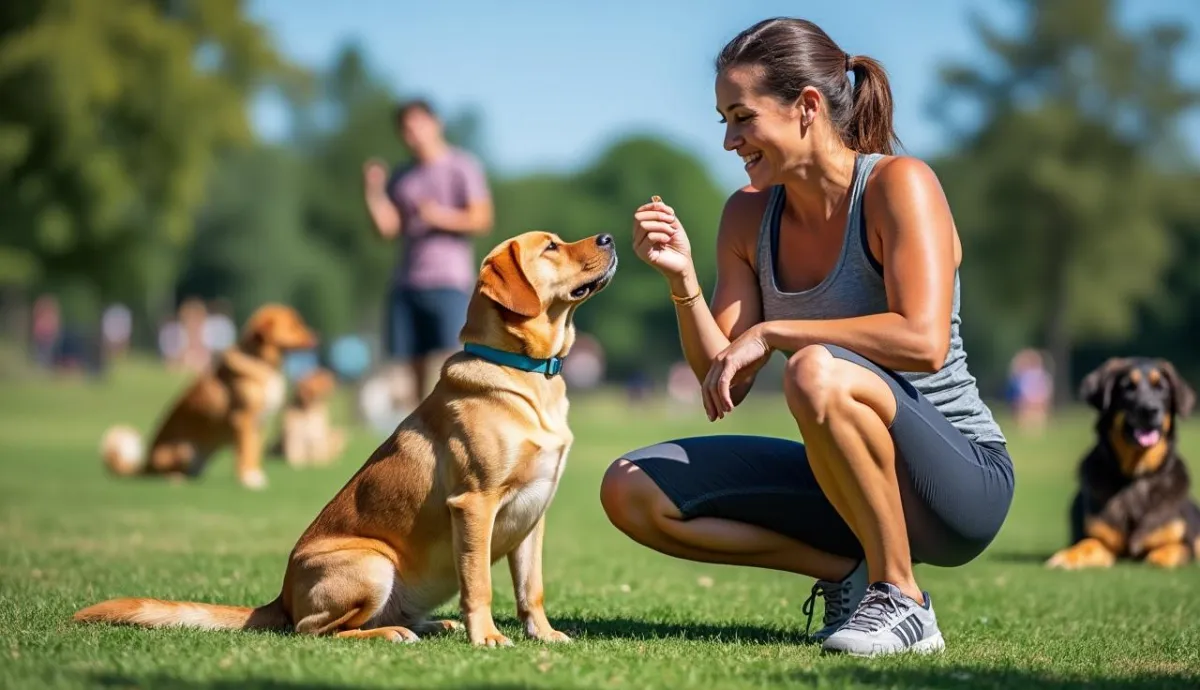
Effective Adult Dog Obedience Training Tips
Teaching adult dog obedience training is different from training puppies. But don't worry - it's totally doable!
Want to know the best part? Adult dogs often learn faster than puppies because they can focus better.
Sure, your grown-up dog might have some old habits. Maybe they've picked up some not-so-great behaviors over the years. That's normal! The key is knowing how to work with their experiences, not against them.
Training a mature dog just needs the right game plan. You'll need some patience, lots of treats, and a bit of know-how. But here's what's amazing: most adult dogs can learn new tricks in just a few weeks.
I'm going to show you exactly how to train your adult dog, step by step. We'll use methods that work specifically for older dogs, making it easy and fun for both of you.
Understanding the Adult Dog Learning Process
Let's face it: teaching an old dog new tricks isn't impossible - it's just different!
Your adult dog brings a lifetime of experiences to training. Some good, some not so great. Think of it like transferring to a new school - past experiences shape how quickly your pup adapts.
Dogs who've had previous training often pick up new commands faster. It's like building on existing knowledge. But if your furry friend missed out on early training, don't worry! They can still learn - we just need to be extra patient.
Here's something crucial: emotional baggage is real for dogs too. Maybe your rescue pup had a rough start. Or perhaps they're just naturally shy. Understanding their past helps us move forward.
Quick tip: always start with a behavior check. Watch how your dog reacts to:- Different sounds- New people- Other animals- Various environments- Basic commands
Your dog's current skills are like building blocks. If they know "sit," that's fantastic! We can use that to teach more complex stuff.
Creating a perfect training space matters big time. Pick a quiet spot where your adult dog feels safe. No squeaky toys, no doorbell rings, no distractions.
Remember those creaky joints! Older dogs might need shorter training sessions. Maybe a soft mat for comfort while learning "down."
Common Training Stressors:| Stressor | Solution ||-|-|| Loud noises | Train in quiet rooms || Long sessions | Keep it under 10 minutes || Hard surfaces | Use cushioned mats || Too many commands | Focus on one skill at a time || Unfamiliar places | Start at home first |
Start training in their happy place - usually a quiet room at home. Once they've got the basics down, slowly introduce new spots. Maybe the backyard next, then the park during quiet hours.
The secret sauce? Taking baby steps. Don't rush from couch training to dog park practice. Build confidence gradually, and watch your adult dog become a star student!
Building a Progressive Training Framework
Listen up, dog lovers! Training an older dog isn't as tough as you might think.
Your mature dog is like a wise friend who just needs the right motivation. They're not stubborn – they simply have different drives than puppies.
Let's look at what makes older dogs tick:
Age GroupBest MotivatorsTraining Duration2-5 yearsFood + Toys15-20 minutes6-8 yearsFood + Praise10-15 minutes9+ yearsGentle Praise5-10 minutes
Adult dogs thrive on consistency and routine. Think of them as seasoned pros who need a coach, not a drill sergeant.
Here's what really works with mature dogs:- Short, focused training sessions- Positive reinforcement with age-appropriate rewards- Regular exercise matched to their energy level- Clear, simple commands- Patience and praise
Your dog's energy level is key to successful training. A tired dog isn't a good student. Watch for signs they're ready to learn – tail up, ears forward, eyes bright.
Want to know a secret? Body language is everything. Your dog reads you like a book. Stand tall but relaxed. Keep your movements smooth. When you say "sit," don't wiggle around!
Timing matters more than you'd think. Reward your dog within two seconds of the right behavior. Any longer, and they won't connect the dots.
Make each command count. Use the same word, same tone, same gesture – every single time. Your dog will pick up on these patterns like magic.
Remember this golden rule: what works for one dog might not work for another. Some love belly rubs more than treats. Others live for their favorite squeaky toy.
Keep it fun, keep it simple, and watch your mature dog become the star student you always knew they could be!
Maximizing Training Success Through Relationship
Want to know the secret to amazing dog training? It's all about building a real connection with your furry friend.
Think of training like making a new best friend. You wouldn't boss around a friend, right? The same goes for your dog.
Let's start with respect. Your dog needs to see you as a trusted guide, not just someone who gives treats. Get down to their level, watch their body language, and learn what makes them happy or nervous.
Trust comes next. Play simple games like "follow the leader" or gentle fetch. These fun moments create a strong bond between you and your pup. The more you play together, the more your dog will want to learn from you.
Create special training times that your dog looks forward to. Maybe it's right after breakfast or before dinner. Keep these sessions short and sweet - just 5-10 minutes works great!
Here's what makes training fun for both of you:• Use happy voice tones• Give lots of gentle pets• Keep treats small and tasty• Take breaks when needed• End on a good note
You don't need to be the "alpha" to be a good trainer. Just be consistent and kind. Your dog will naturally want to follow your lead when they trust you.
Stay connected during training by reading your dog's signals. If they seem tired or frustrated, take a break. Remember to smile - dogs can tell when you're happy!
Training Time TipsWhy It WorksMorning SessionsDogs are fresh and eagerAfter WalksThey're calm and focusedBefore MealsNatural motivation timeQuiet EveningFewer distractions
Keep practicing these relationship-building tips, and you'll see amazing results in your training journey. The best part? You'll have more fun together too!
Training an adult dog takes time and dedication, but the results are worth every moment. Your furry friend can learn new tricks and better behaviors at any age. The key is staying patient and consistent with your training approach.
Here's what matters most:
Keep practicing the skills you've learned together. Make training a fun part of your daily routine. Just 10 minutes each day can make a huge difference in how well your dog listens and behaves.
Remember that every dog learns at their own pace. Celebrate small wins along the way. When your dog masters a new command or shows better behavior, give lots of praise and treats.
Most importantly, keep building that special bond with your dog. Good training creates trust and understanding between you both. With time and love, your adult dog can become the well-behaved companion you've always wanted.

